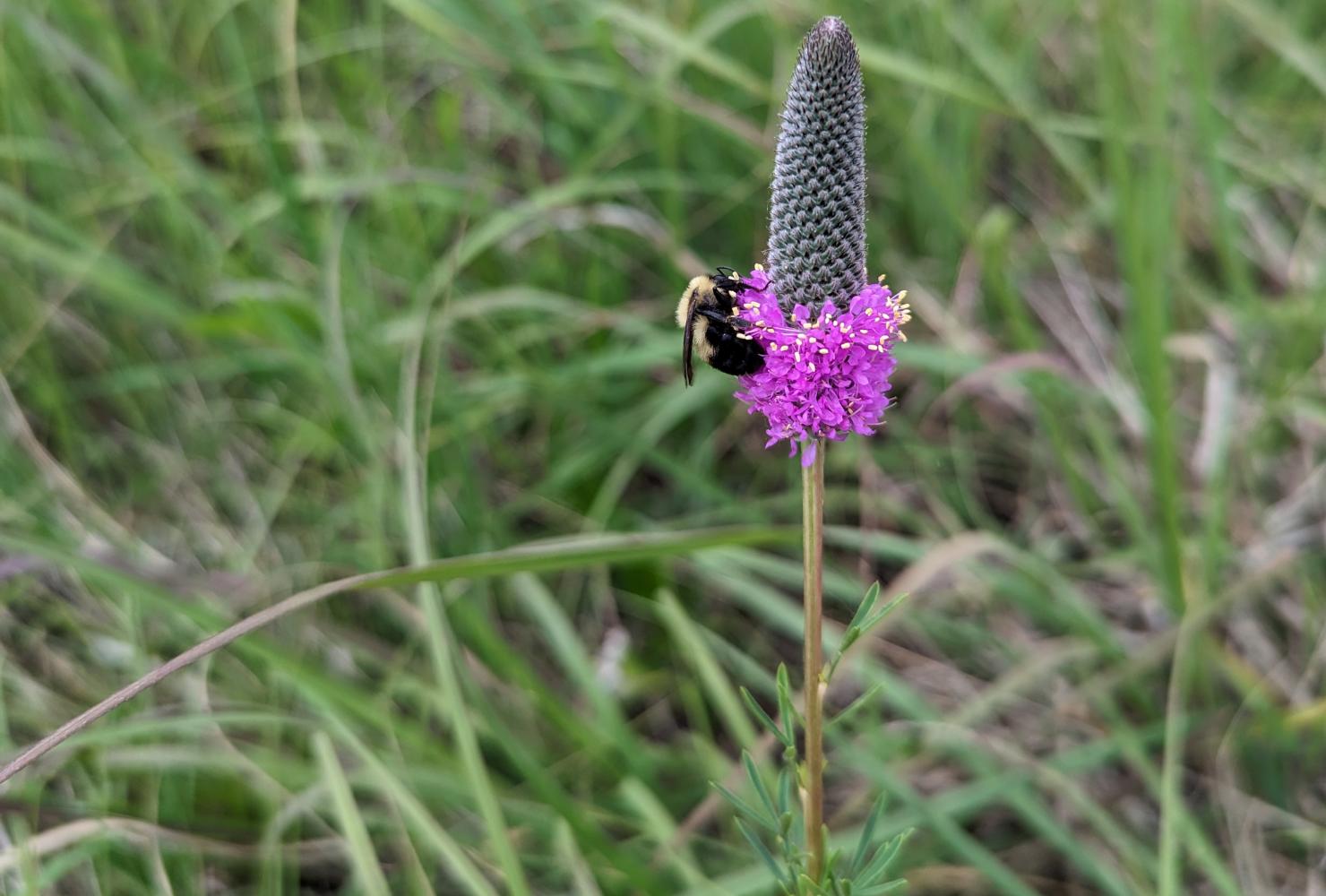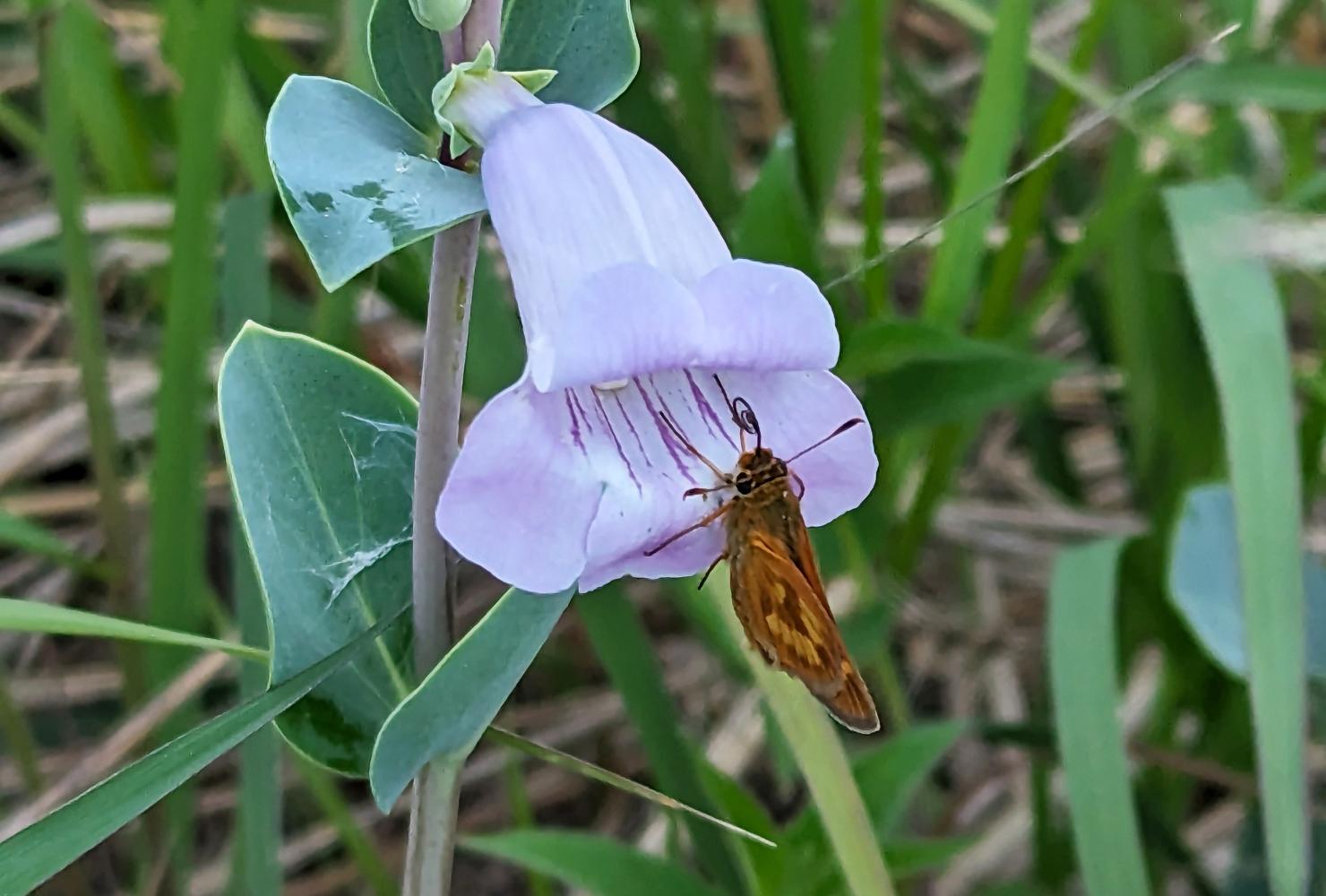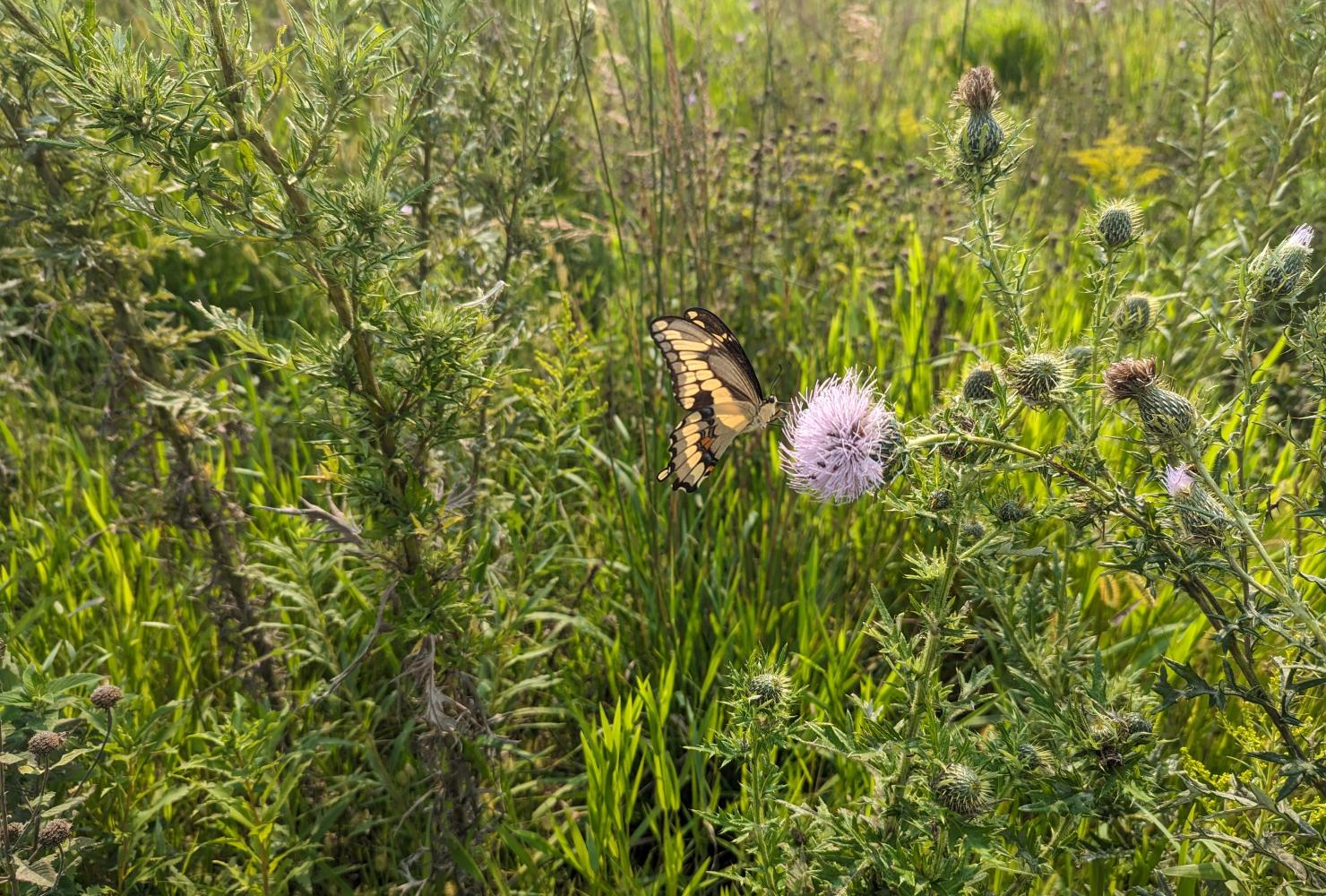More than 3,000 pollinators — and other interesting findings from our 2023 monitoring
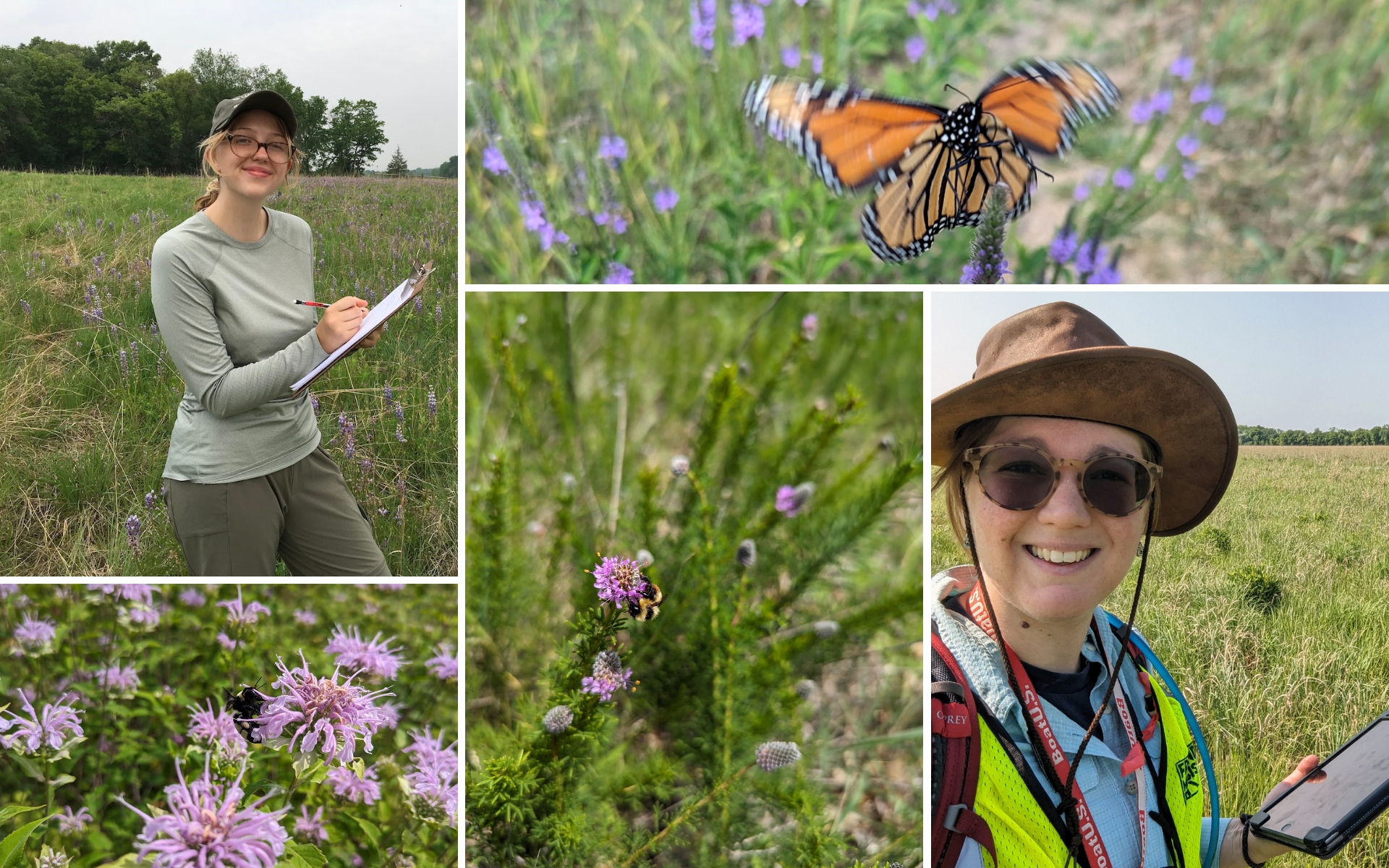
We found more than 3,000 pollinators in our summer surveys this year. Pictured here: monarch butterfly, black and gold bumble bee and red-belted bumble bees.
Our annual pollinator monitoring once again demonstrated that together we've created metro habitat restoration sites that can support a diverse community of bumble bees, butterflies and other native pollinators.
We've rounded up a few of our most interesting findings to share. Take a guess at some of our results before reading on: How many pollinators did we find at five sites this summer? How much more often did pollinators visit native flowers than non-native flowers? And why are cuckoo bees a good sign?
While we look back at the 2023 data, we're also looking ahead; we've got a slate of research questions for 2024, new ways to improve rusty patched bumble bee habitat and new opportunities for you to help with monitoring efforts.
Why we monitor wildlife
The Land Conservation program at FMR works with landowners and partners to protect and restore critical lands that are ecologically linked to the Mississippi River throughout the Twin Cities metro area. One of our goals is that these restored lands will, in turn, help protect and restore the species and populations that depend upon them for habitat.
In order to evaluate how well these lands are providing habitat, research and monitoring are essential. FMR has monitored breeding and migratory bird species presence at our sites for many years. Since 2018, we have also monitored pollinators at a subset of sites.
Seeing pollinators return to a restored farm field like the William H. Houlton Conservation Area in Elk River over the past five years is an indicator that FMR's restoration efforts are improving habitat for pollinators and a hopeful sign that the surrounding natural areas support a diversity of pollinator species able to return to such sites once restoration has begun.
Five interesting findings from our 2023 pollinator monitoring
Last summer, FMR intern Annika and I monitored pollinators in restored and remnant prairies at five of our sites. We're still analyzing the data, but wanted to share some of our totals and findings so far. But first, a note about our methods: We surveyed sites using timed meandering or transect walks once a month from June to September. This means we walked a particular route and recorded every insect that we saw within a few feet of us that was collecting pollen or nectar during four visits per site. Here's what we observed.
We documented over 3,000 pollinators belonging to over 65 species or groups, including 13 bumble bee species and 26 butterfly species.
This kind of species diversity and abundance is right on par with what I'd hope to find at a restored site — higher, in some cases. The bumble bee diversity we observed, for example, was slightly higher than I expected.
You'll find the "big three" (common eastern bumble bee, two-spotted bumble bee and brown-belted bumble bee) at most sites, and then most likely a few "tier 2" bumble bees, like the black and gold bumble bee or the half-black bumble bee. I was excited to find that all of the sites we monitored also supported a few less common bumble bee species, like the lemon cuckoo bumble bee.
Other numbers, like the 65 species or groups we observed, underrepresent the true pollinator diversity present. All our pollinator monitoring is done non-destructively by sight or photograph in the field. Because many pollinators, including most of Minnesota's 500+ native bee species, cannot be identified to the species level without using lethal collection methods and microscope identification, this species count is most representative of bumble bees and butterflies and a few other groups of field-identifiable pollinators. The true diversity of other pollinator species at these sites is likely much higher!
We observed pollinators visiting 68 different flower species.
A typical pollinator seed mix for a restoration might include 20-30 flower species; this finding tells us that pollinators are using many more species than that, if available! Not all species were present at all sites, and not all species were in bloom at the same time. To see pollinators using such a variety of available flower species across sites and seasons drives home the importance of plant diversity in a restoration.
Which plants did these pollinators visit the most? Bumble bees and butterflies visited anise hyssop (Agastache foeniculum) and bee balm (Monarda fistulosa) most frequently, while we more commonly observed other native bees on field thistle (Cirsium discolor) and bee balm (Monarda fistulosa). Beetles preferred anise hyssop (Agastache foeniculum) and gray-headed coneflower (Ratibida pinnata). Flies and wasps preferred stiff goldenrod (Solidago rigida).
If you're interested in adding some of these plants to your own yard, check out our webpage on planting native species for the river.
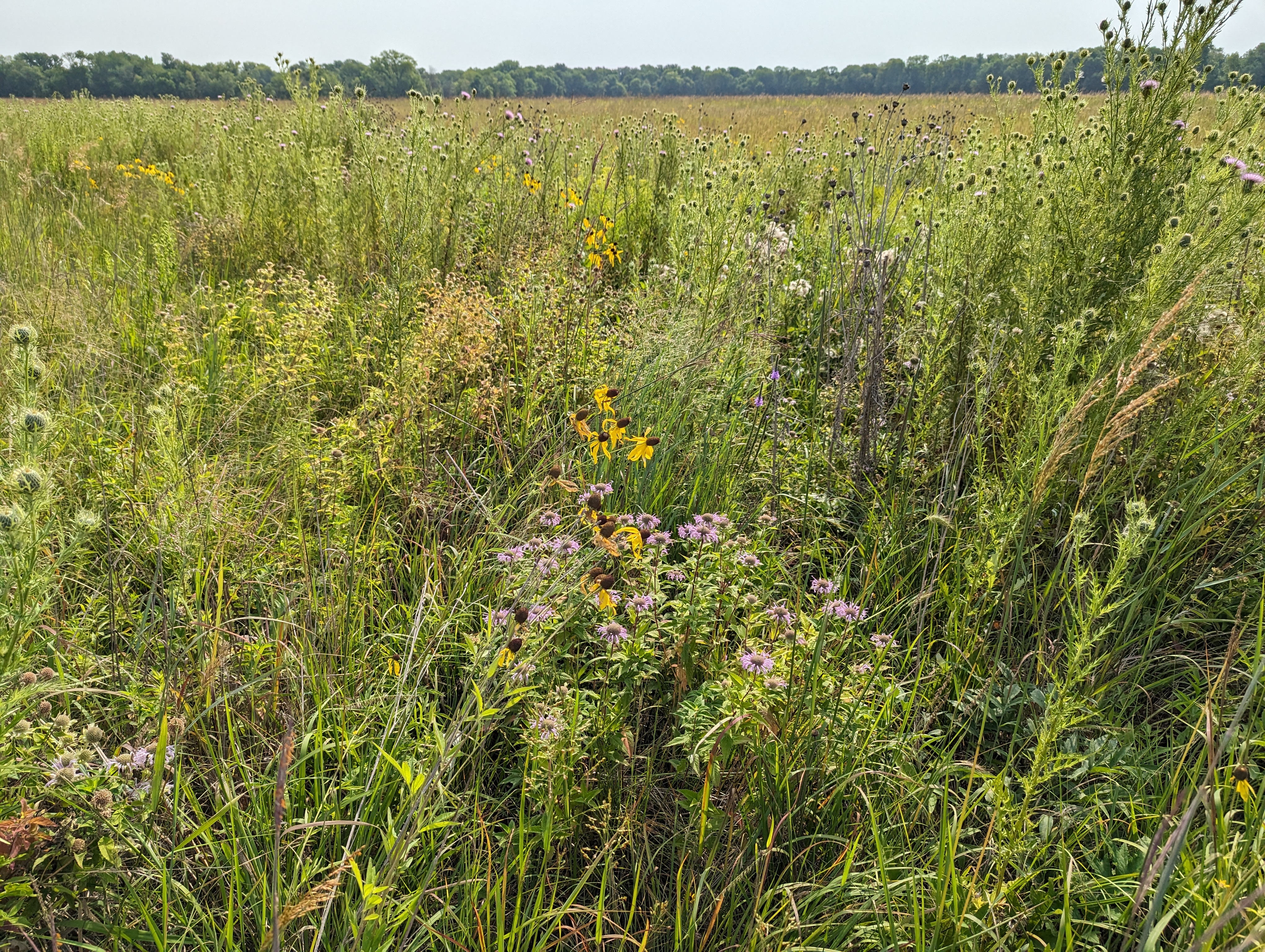
August wildflowers like coneflower, bee balm and thistle bloomed at William H. Houlton Conservation Area, a former agricultural field turned prairie. The diversity of wildflowers at this site provides pollen and nectar resources for pollinators.
Overall, pollinators visited native flowers 42 times more often than non-native and invasive flower species at our sites.
This statistic is, in part, a reflection of the success of native plants within our restorations, but also a reminder of the important role native plants and pollinators play in supporting one another. At our sites, honey bees, which are not native and were introduced with European colonization, visited native flowers only 3.5 times more often than non-native and invasive flowers. This contrast illustrates the point that while non-native plants may provide sufficient resources for some non-native pollinators, our native pollinators are relying primarily on native plants.
We found cuckoo bees at all five sites, usually the last to the party at a successful restoration.
Of the native bees we recorded, cuckoo bees, like those we observed at all five sites this summer in the genus Sphecodes, are exciting to see because they are kleptoparasitic — they feed their offspring on pollen collected by other bees, especially those in the genera Lasioglossum, Halictus and Andrena.
Kleptoparasitic species tend to be among the last to recolonize restorations since their host species must already be established. Their presence is an indicator that the restoration work at the sites we monitored is going well.
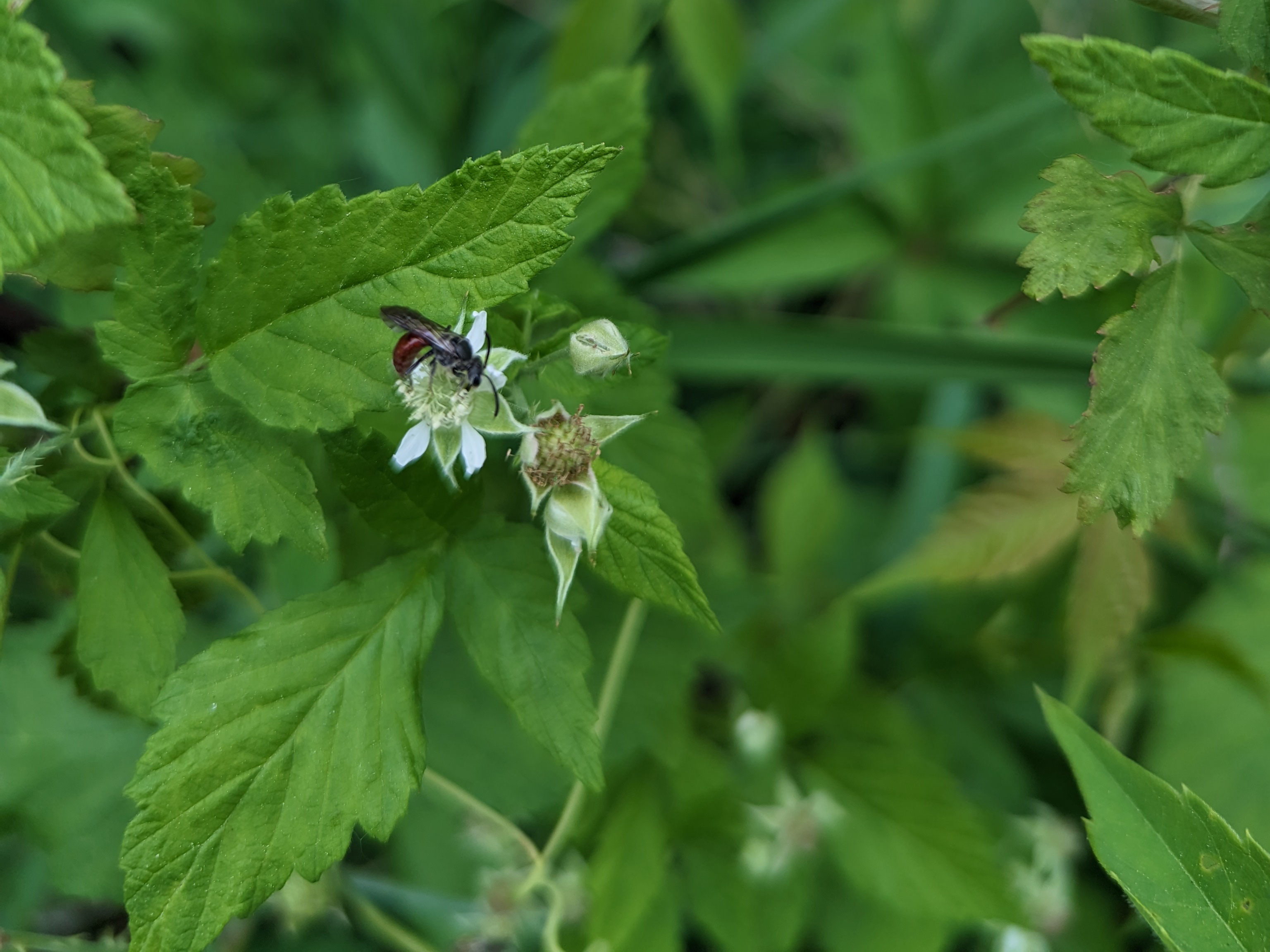
We found this cuckoo bee on raspberry at W. H. Houlton Conservation Area in Elk River.
We didn't see as many skipper butterflies as we hoped.
One group of pollinators we didn't observe or observed only in low abundances during the 2023 surveys was skipper butterflies (Hesperiidae family).
Many skipper species feed on native grasses during their larval stage and build shelters for overwintering at the base of these same native grasses. They're considered prairie specialists. Several once-common Minnesota species are now federally endangered (like the Poweshiek skipperling) or threatened (like the Dakota skipper), and many others appear to be in decline.
Why didn't we see many skippers? There may be many reasons for their absence at restoration sites in the metro area. One likely contributing factor is that most skippers can't travel far as adults. If there are no well-established populations of these species near enough to a restoration site, they may simply be too far away to recolonize a site that lost them.
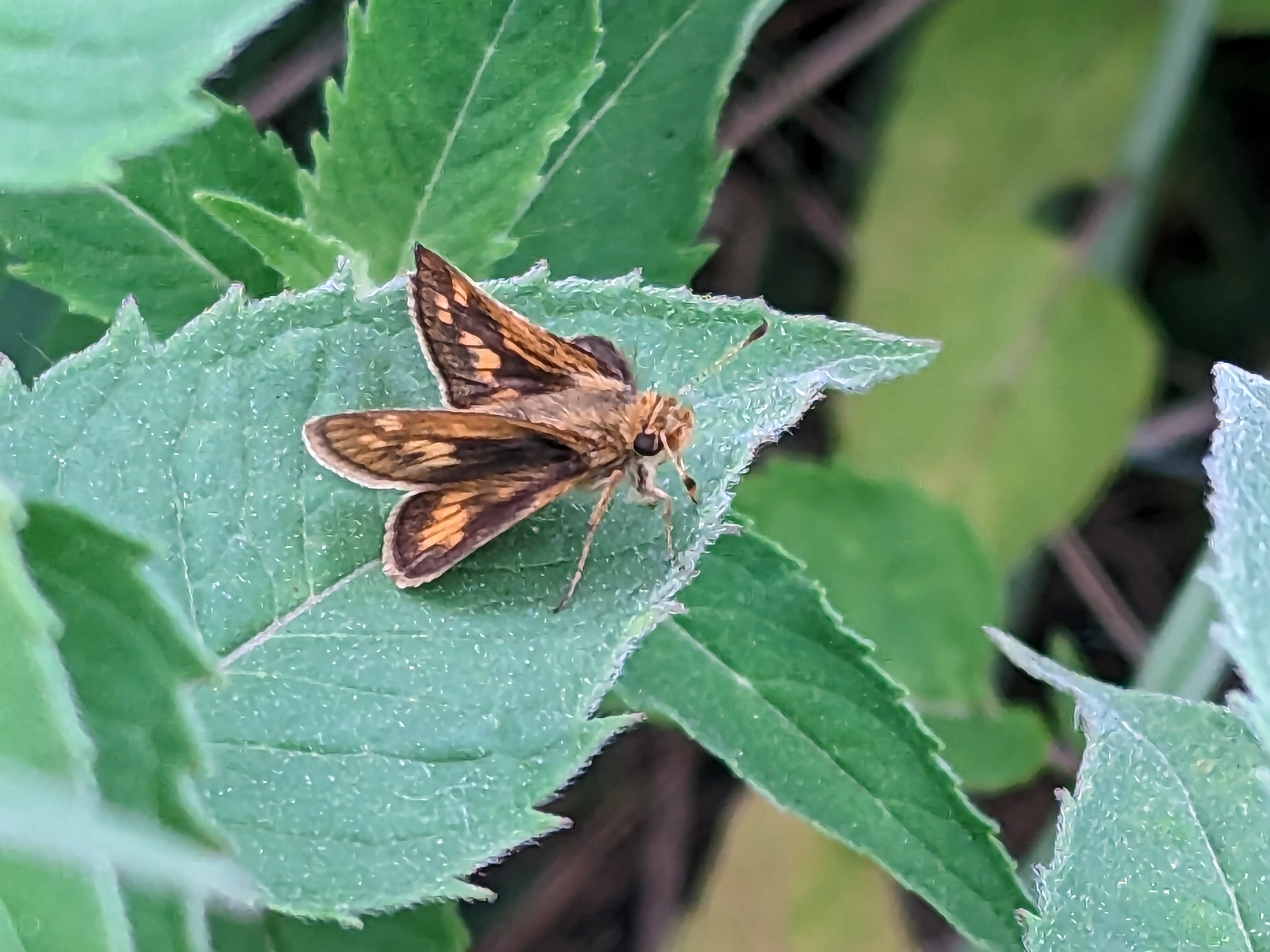
Peck's skipper (not endangered) perched on a plant during our pollinator survey at Vermillion River Linear Park in Hastings.
Fortunately, there are several things we can do to improve the habitat conditions for skippers.
One big improvement would be building landscape connectivity so that healthy populations could recolonize new sites nearby. Watch this video to learn more about FMR's work on habitat corridors. Boosting native grass coverage and diversity may also improve the habitat for these species, many of which feed and shelter-build exclusively on native prairie grasses.
Careful consideration of the approach to using prescribed fire is important as well. Although prairie skipper butterflies depend on fire to maintain their habitat, direct fire mortality is also a risk. We don't burn entire sites at one time; rather, we leave areas intentionally unburned to provide refugia for these species during burns.
Continued pollinator monitoring at our sites can help us determine whether our restoration efforts are having a positive impact on skipper populations.
Our research in 2024
The rusty patched bumble bee (Bombus affinis) was listed as federally endangered in 2017. Most of our sites lie within the "high-potential zone" for this species, a geographic zone with the highest potential for the species to be based on modeling of known landscape and natural history characteristics.
This year, unlike previous years, we didn't observe any rusty patched bumble bees at our sites in 2023. But we're excited by the prospect of new discoveries in 2024.
Thanks to LCCMR funding from the Environmental and Natural Resources Trust Fund, we'll embark on a new research project assessing habitat suitability for the rusty patched and other native bumble bees at several of our restoration sites for the next several years.
We'll be asking these research questions:
- What restoration seeding methods and seed mix diversity levels provide the best habitat for bumble bees?
- How do habitat assessment tool predictions compare with our on-the-ground field surveys?
- How do prairie restorations differ from prairie remnants (areas that have remained prairie since before European colonization) in terms of bumble bee habitat?
This research will not only help guide our own restoration efforts at FMR but will inform the work of other conservation practitioners and contribute to a growing wealth of data and scientific knowledge within the broader scientific community. Understanding where our restoration efforts are successful or lacking in their provision of bumble bee habitat can help us prioritize time, effort and funding for the activities most likely to have a positive impact on the pollinators we need and love.
Join us!
Sign up for our enews to stay tuned about ways to be involved in habitat restoration and pollinator monitoring this summer.
In addition to volunteer restoration events like prairie planting and seed collecting that help improve pollinator habitat, we'll be expanding our offerings to include several new community science events, like monarch larva monitoring with volunteers. Hope to see you in the field! Meanwhile, here are five other ways you can support pollinators.
And thank you to our partners and funders (Outdoor Heritage Fund, Environmental and Natural Resources Trust Fund, National Fish and Wildlife Foundation, Marathon, 3M and Flint Hills) for supporting this important work.
